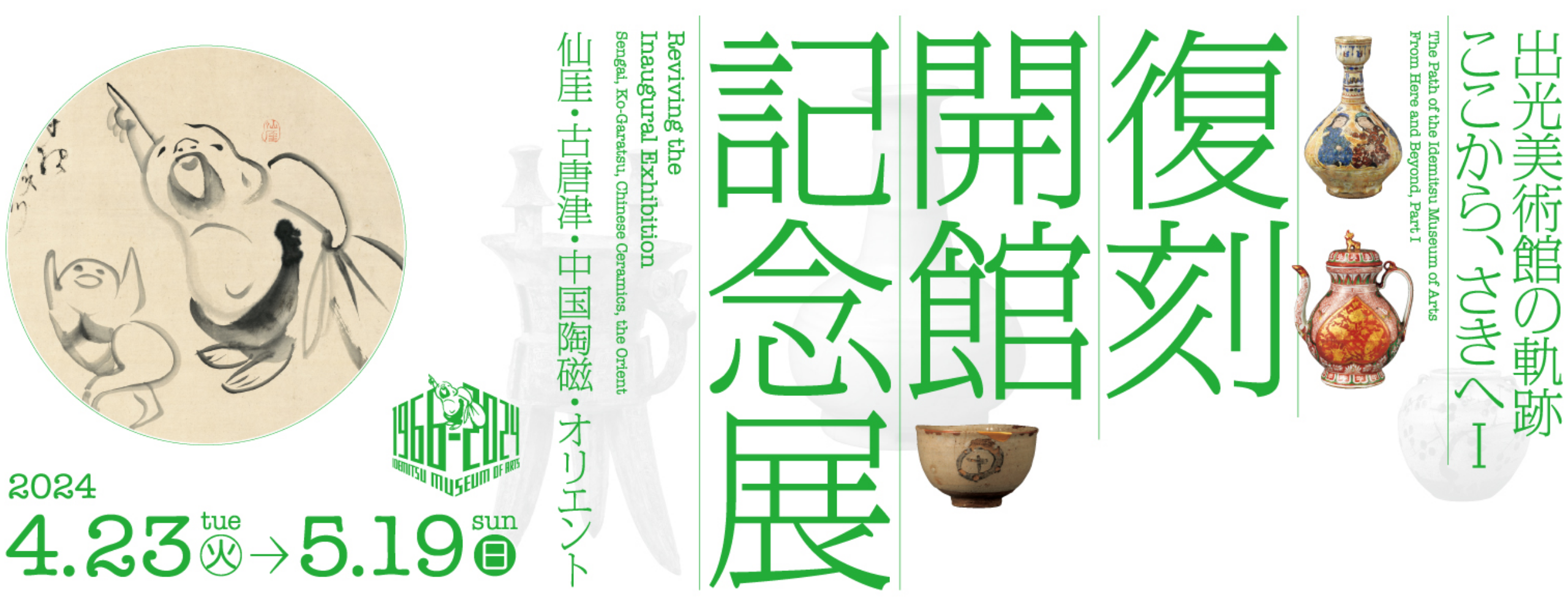- TOP
- Exhibitions
- Ⅰ
-
- April23Tue
- May19Sun, 2024
Reviving the Inaugural Exhibition―Sengai, Ko-Garatsu, Chinese Ceramics, the Orient
At the museum inaugural exhibition in 1966, the gallery rooms showcased major works of Chinese ceramics and bronze, ko-garatsu (old ware from the Karatsu region), and Zen master Sengai’s paintings. Today, fifty-eight years since its public opening, all the rooms remain with their original structure and style. To begin the museum’s final year in its current Teigeki building, this first exhibition revisits the museum inaugural exhibition and features masterpieces that continue to represent the collection of the Idemitsu Museum of Arts.
Exhibition Works
Sengai
-

Hotei (Budai) Pointing at the Moon
Japan 19th Century
-

The Willow
Japan 19th Century
Ko-Garatsu
-

Tea Bowl with Design of Cross-in-Circle
Japan Late 16th-Early 17th Century
-

Jar (Water Jar) with Three Ears and Design of Persimmon
Japan Late 16th-Early 17th Century
Chinese Ceramics
-

Vase with Pear-Shaped Body
China 12th-13th Century
-

Pitcher with Design of Peacocks, and with Seal of "Fu Gui Jia Qi"
China 1522-66
The Orient
-

Bottle with Design of Seated Figures
Iran 12th-13th Century
-

Pitcher with Bird-Shaped Head
Iran 12th-13th Century
Bronze Ware
-

Sigong, Wine Vessel with Design of Taotie Dragon and Birds
China 11th-8th Century B.C.
-

Pair of Jia, Wine Vessels with Design of Taotie
China 13th-11th Century B.C.
Introduction of Chapters
-
Chapter 1 Ko-Garatsu
Ko-Garatsu ware have been known for their modest nature, as they have been named “Korean-like style ceramics that are modest like a wild samurai.” On the other hand, Karatsu ware have been produced by many potters across the Hizen region, which created various styles. The first museum director, Idemitsu Sazo (1885 - 1981), was drawn to the beauty of Ko-Garatsu ware and vigorously collected them, resulting in a rich collection of over 300 works. This chapter focuses on Ko-Garatsu ware that have represented tea ceramics as in the phrase “first, Raku ware, second Hagi ware and third Karatsu ware” and further, that have led the so-called “Age of Large Dishes.”
-
Chapter 2 Sengai
Sengai (1750-137) who is also endeared as “Sengai-san of Hakata” created zen-ga (Zen paintings) with a heartwarming and modest touch. Based on his saying “Gaiga Muhō (a free style of painting unrestrained by any painting method and style),” Sengai’s works are portrayed with free-flowing brushstrokes. However, his works also contain Zen teachings and thus some praise that “no one other than Sengai can freely express Zen Buddhism on calligraphy and paintings.” We hope you enjoy his works that were shown in the Sengai Room when the Idemitsu Museum of Arts was founded.
-
Chapter 3 Chinese Ceramics
Chinese Ceramics were one of the earliest works collected as part of the Idemitsu Collection. In the late 1910s, Sazo encountered Chinese ceramics in Dalian city and found solace in their calming beauty. Later, he visited antique vendors in Beijing and Tianjin in search of Chinese ceramics. In addition to Chinese ceramics of the karamono (Chinese items) type that have evolved through tea ceremonies and flower arrangement in Japan, this chapter features Tang sancai (three-color glaze ware) as well as Jun kiln ware and blue and white ware of the Jingdezhen Official Kiln of the later dynastic periods that have especially gained attention from the modern period onwards. Please enjoy a selection of ceramics from various time periods and regions.
-
Chapter 4 The Orient
In the region of the Orient, known as the origin of Egyptian and Mesopotamian cultures, areas around the Nile River, Tigris-Euphrates Rivers, and further the Eastern Mediterranean Sea have been sites of distinct, beautiful cultures. Magnificent fine arts and crafts such as gorgeous silver and gold ware, vibrantly colored glass ware, and highly decorative ceramic ware are found, all of which exert an exquisite aura. The region of the Middle East has been connected to East Asia through land and maritime routes since the ancient times and has thus been the site of cultural exchange since then. The Idemitsu Museum of Arts has focused on treasures of the Orient from such connections and regions since its founding.
-
Chapter 5 Bronze Ware
Bronze ware have been long praised as treasures of ancient China and further as fine art. Such bronze wares representative of Chinese culture were created from about 1800 B.C. Later, in the Shang and Zhou dynasties where people were highly devoted to religious beliefs, many lively-looking and extraordinarily detailed works were created that can be said to reflect the spirituality of the ancient Chinese people. Sazo collected and appreciated such bronze ware as physical material that testifies the history and as the origins of Chinese art.





